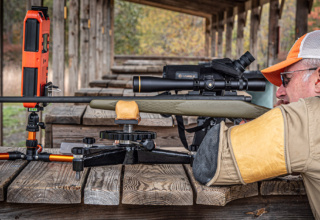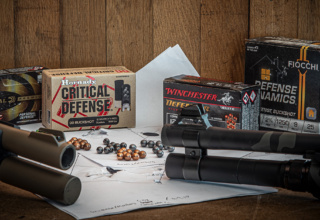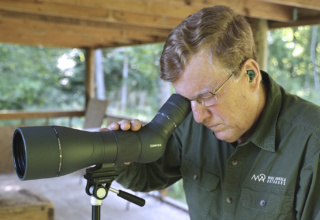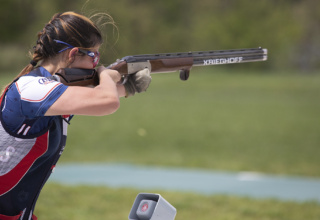The author employs the MG Arms Ultralight LR in 6.5 PRC to attempt a halo shot with this standout hunting rifle
by Mike Arnold
“Umm, I’m not certain you’ll reach the mile target with this rifle.”
Not only his words, but his skeptical tone came through loud and clear.
I was on the phone with Kerry O’Day of MG Arms, the designer of the 6.5 PRC lying on the bench in the reloading area of my home in Georgia. I replied with, “Hey, you call this prototype the Long-Range model, and we discussed its capabilities when I interviewed you last February at the Safari Club International Convention. Besides, I joined the one-mile club using your Behemoth rifle.”
Kerry joined back in with, “Yeah, but when we wrote Long-Range, we weren’t really thinking that meant out to a mile. And, as you know, the chambering on our Behemoth is 50 BMG, with the specific application of hitting targets at a mile or more.”
My sigh probably penetrated all the way down the phone line to Kerry and Carol O’Day’s MG Arms headquarters in Spring, Texas. As my sigh trailed off, I suggested we wait and see what happened when I took the rifle to Clinton House Plantation’s long-range course, pairing up again with their shooting coach, Mike Sexton. The interaction with Kerry might not have been exactly encouraging about my goal of hitting a mile target, but I trust MG Arms products. Having reviewed many of their rifles and multiple pistols, I knew two things — Kerry and Carol and their staff produce very accurate guns, and they refrain from blowing smoke up peoples’ skirts…or pants.
Unlike the Behemoth, I did not begin my review work on the MG Arms LR rifle at the one-mile range. My local club in Elberton, Georgia, does not want their berms blown apart with the power of the 50 BMG, so I could not start there with the Behemoth. The 6.5 PRC, though, was range acceptable, and so I headed to the Elbert County Gun Club and their 100- to 400-yard course. Since I would use my Kestrel Ballistics Meter when shooting at the long-range targets at Clinton House, one piece of information needed was the muzzle velocity of the Hornady 6.5 PRC 147 ELD® MATCH ammunition kindly sent my way by Hornady’s Seth Swerczek. In my experience, Hornady, like MG Arms, is known for not producing Blue Sky pronouncements about their products. With Hornady, that means I find their reported muzzle velocities, on the box and their website, very close to that recorded on my LabRadar unit. This time was no different. Hornady’s mean muzzle velocity value for the 147-grain ELD ammunition = 2910 fps. The mean speed of eight shots recorded by my LabRadar = 2884 + 10 fps. As usual, I input my estimates into the Kestrel, but honestly, the Hornady value would have worked just as well.
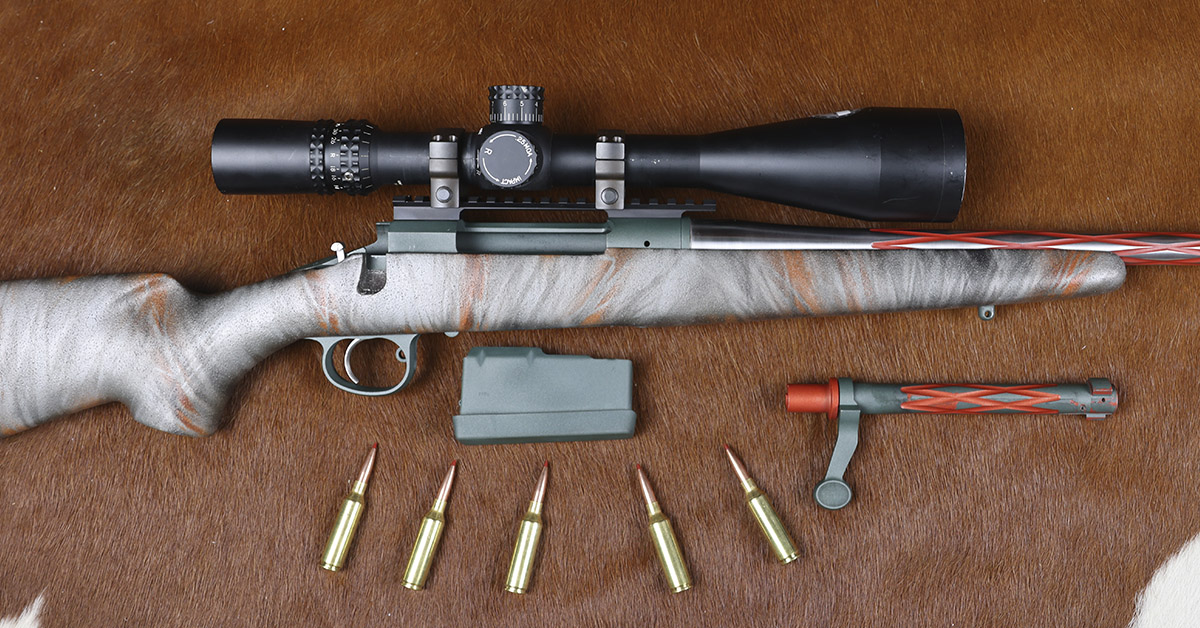
I used the shots for the velocity estimates to also acquire groups at 100 and 200 yards. I initially sighted the rifle in for 2 inches high at 100-yards, fired three more rounds for a group diameter, and then moved to the 200-yard target. I fired three shots at this target and then shifted the sights and parallax for 300 yards. When I worked with Mike Sexton and the MG Arms Behemoth, he had me zero at 300 yards. Once I fired my three-shot ‘accuracy’ group, I adjusted the sights so that the next three shots went into the aim point. Again, resetting the parallax and turning up the magnification (I do have 67-year-old eyes after all!), I finished off by firing three rounds at the 400-yard target. The Hornady ammunition plus MG Arms rifle combination gave excellent groups at all distances — sub-1xMOA out to 400 yards. These data provided confidence that attempts at longer range targets — even one-mile — had a good chance of success. Besides, I’d love to surprise Kerry and Carol by lighting up the LED indicators on the one-mile steel!
Going for the Distance
Like our first visit to Clinton House Plantation the previous fall, the attractiveness of the landscape and the clubhouse/pro shop provided a wonderful welcome. The facilities are extremely well-maintained and well-managed, and the staff are friendly and welcoming to both professional shooters and us non-pros. For shooters, the multiple sporting clays courses, pistol bays, and rifle ranges positioned throughout the Plantation’s property provide the raison d’être for our being there.
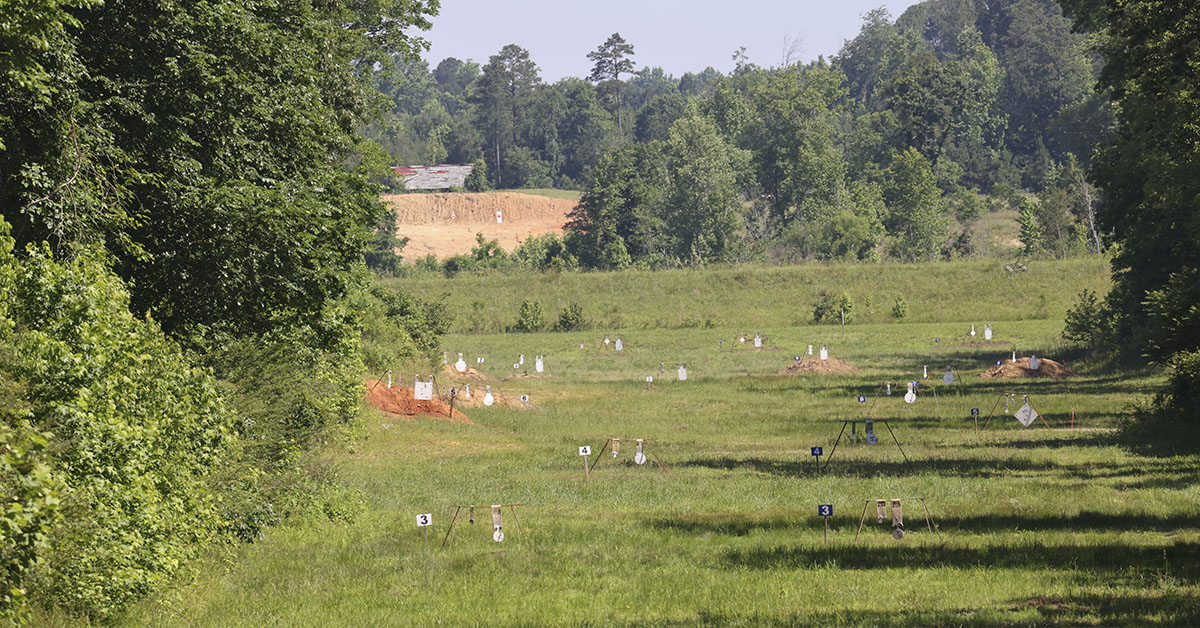
Checking in at the pro shop took a matter of minutes, with directions given to the 1000-yard course. Mike texted the day before, letting me know that he would arrive at 10 am, so Frances and I made our appearance at 9 am. This gave us plenty of time for initial photography and setting up all our equipment. Once we unloaded all our gear into the elevated shooting stand, I looked at the course. Mike and his staff had metal targets scattered across the field, beginning 300 yards from the stand and ending with the 3xMOA, 1000-yard silhouette. And, behind the berm at the back of the 1000-yard range, past a tree line, some 700+ yards further on, were the two targets set at one-mile from the elevated stand. With the naked eye, the two targets looked more like white toothpicks against the red clay berm behind them.
Whenever I arrive at a long-range course to review products or the facility, I become a bit quiet. As my family and friends know, this is a sure sign that I am very nervous. I never have gotten over the feeling of inadequacy when facing the task of hitting targets at distances of 10 football field lengths or more. On the other hand, I think placing myself into uncomfortable situations is the best opportunity for achieving goals never thought possible. I can’t say that was uppermost in my mind while staring at the barely visible targets, but on reflection, I think it’s an accurate assessment. But enough introspection.
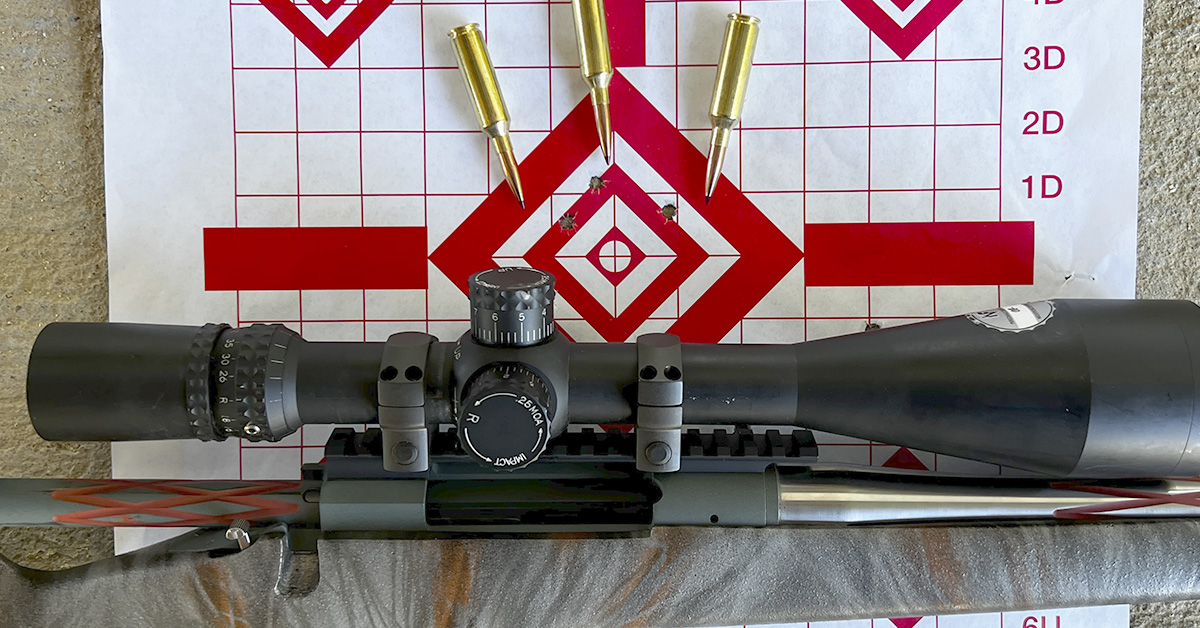
Mike drove up just as we were finishing our photography and setup. Unloading his range box — containing among other things his Swarovski optics and tripod, which he would use for calling my impacts…and misses — he climbed the steps into the elevated stand. It took Mike a few minutes to set up his viewing area, but once ensconced in his folding chair, with Swarovski binoculars at eye level, we were ready for the session. Mike asked me to verify the zero of the MG Arms rifle at 300 yards. Having established that, and with the Kestrel Ballistics Meter reset for 500-yards, we tried again. And, again, we achieved multiple back-to-back impacts, indicated by a metallic clang and swinging target.
It might seem for most shooters, like yours truly, who limit their target practice to 400-yards, that a 500-yard target would bring with it a significant degree of difficulty. And that is correct. But for me, the 1000-yard distance is where I really start to sweat. Yes, with a sight-in at 500-yards and a Kestrel Meter, an accurate elevation adjustment on the ballistic turret is relatively certain; however, if there is any breeze, windage becomes the issue. For example, with a 5-mph crosswind, bullets of approximate design as the one firing from the MG Arms 6.5 PRC could drift as much as 11 inches at 500 yards and 50 inches at 1000 yards.
The Clinton House Plantation long-range course hosted a ~ 5 mph crosswind at 1000 yards, necessitating drift compensation. My ace-in-the-hole sat behind me with his eyes glued to the Swarovski optics.
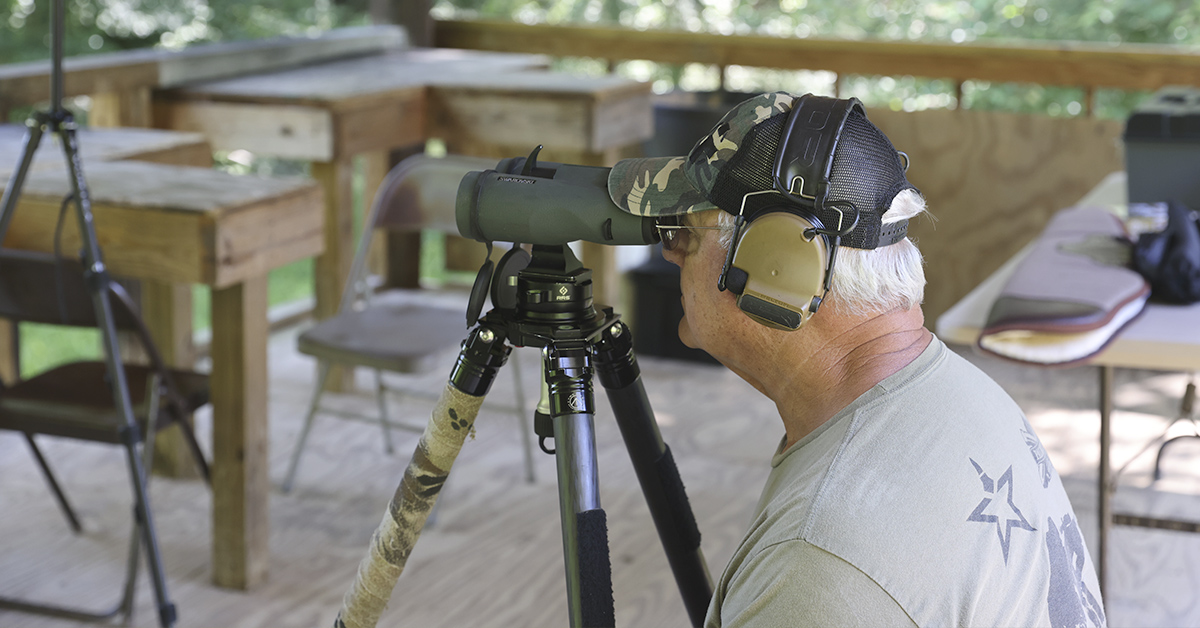
Mike retired from the Marine Corps as a Chief Warrant Officer; the training while in active service, and his innate ability, resulted in two National Champion titles in three-gun competitions. With his experience in long-range shooting, Mike easily helps shooters adjust, resulting in the best chance of hitting distant targets in less-than-ideal conditions. Mike’s talents became even more important about 20 minutes later when I began my one-mile attempt.
The wind was alternately swinging the orange ribbon tied to a stake near the 1000-yard target to 45-degrees or so, and then slacking off, as indicated by the ribbon returning to its vertical position. My first shot with a center-hold aim was several inches right of the metal silhouette. “Hold center again, but three inches off the left-side of the target,” Mike called. With that adjustment, five of the next six shots resulted in a clang that reached us after counting one-thousand one, one-thousand two, one thousand three. The sixth shot skimmed just off the left side, with the wind having died down just as I fired. The resulting 2.5 MOA group was reassuring.
Needing to let the barrel of the rifle cool off, we adjusted the Kestrel for the 1760 yards (1 mile) between us and the Holy Grail. This called for an elevation adjustment of approximately 62 MOA. This is when I realized I’d let everyone down by not doing proper preparation. We ran out of MOA elevation adjustments. Fortunately, Mike’s deep experience and the extensive ballistics stored in his brain were brought to bear.
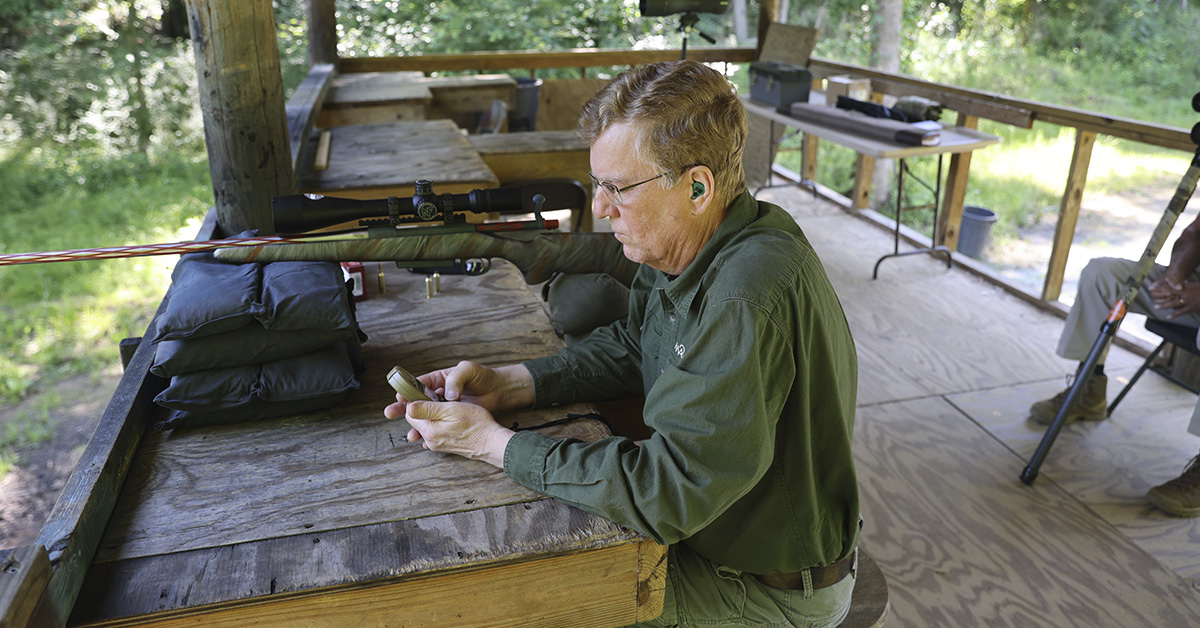
After looking through the riflescope and doing calculations in his head, Mike had me look through the riflescope at the one-mile target. He then said, “Here is what we will do. You see the pine tree behind the one-mile silhouette, just to the right of the storage building?” While staring through the riflescope, I answered with a timid, “Uh huh.” Unfortunately, I thought I knew what was coming; I was right.
Mike continued, “We are going to use that pine to walk you up and into the target.”
I am pretty certain the look on my face was as close to unbelief as it could get. Fortunately, I was facing away from my spotter and coach. My sarcastic thought was, “How the heck will I know to which needle he is referring!”
Mike didn’t allow me to stay in my self-pity too long.
His first direction: “Aim halfway up the pine, and about one target width to the left of the silhouette.” The problem came when I realized I could not see the target when aiming “half-way up the pine.” To aim, I had to move up and down from top of target to Mike’s declared aiming point.

In honor of the non-smoke blowing attitude of Kerry and Carol O’Day, as well as Mike Sexton, I will confess that I did not light up the mile-marker with the first shot, or within the first minute of shooting. In fact, I did not hit the mile target with the first round from the second box of shells used in the attempt. Also, the need to let the barrel cool off every three rounds or so, in the 80+-degrees of South Carolina atmosphere made the mile attempt span approximately one hour. With Mike’s careful coaching, though, in ‘pine tree elevation’ and ‘width of silhouette target windage’ adjustments, I finally heard Mike’s, “That got her!!”
Frances was looking through a Vortex Razor HD 27-60×85 Angled Spotting Scope we were also reviewing on the long-range course, and her, “Hot dang!!” followed just after Mike’s exclamation.
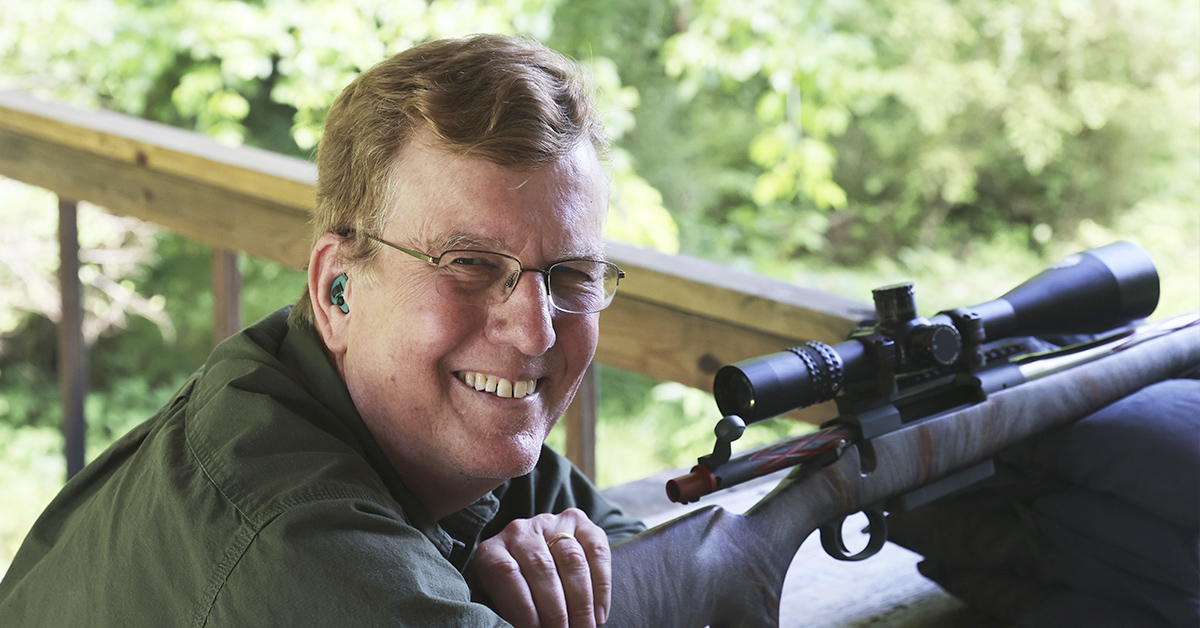
There are many takeaways from my second attempt at reaching a mile target.
Lesson one: always make certain your equipment matches the task at hand. Obviously, I did not do this with the riflescope.
Lesson two is that even with my oversight (pun intended), an excellent coach can make the difference between failure and success.
Third, the accuracy of the firearm used must be superb for hitting a target located at a distance of around 17 football field lengths. MG Arms firearms — and I’ve reviewed many of them now — never fail to amaze me with their inherent accuracy. I really don’t understand the engineering behind this, but I do know that Kerry and Carol O’Day, and their staff, require that each firearm sent out be a tack-driver.
Finally, these exercises in what for me is extremely long-range shooting are the kind of challenges that give the most pleasure when conquered. In other words, I’m definitely going to try this again!
- TESTED: Vortex Razor HD Spotting Scope…Clarity for the Distance - July 24, 2024
- Shooting for the Mile! - June 19, 2024
- Instinctive and Relaxed - May 22, 2024



